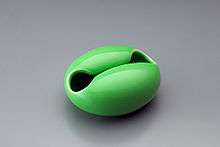Ashtray


An ashtray is a receptacle for ash, typically from combustible consumer products such as cigarettes and cigars. Ashtrays are typically made of fireproof material such as glass, heat-resistant plastic, pottery, metal, or rock. Improvised ashtrays may include coffee cans and glasses.
The most common ashtray design is a shallow cylinder with a flat base, to rest on a table. Other ashtrays, particularly in public places, are wall mounted, and larger than standard tabletop ashtrays due to the increased use they receive. Many ashtrays have notches at the rim, to hold cigarettes and/or a cigar. In Spain, some ashtrays consist of two interlocking parts, the bottom of which is filled with water. Ashtrays are also often built into cars and dustbins, and provided in toilets and other public places.
.jpg)
Ashtrays were not a common part of life until the early 20th century, when cigarette manufacturers began to encourage the development of ashtrays as an American consumer product. The word itself did not come into common use until 1926.[1][2] Ashtrays have been a popular advertising vehicle. Collectors look for ashtrays with clever and unusual ads, colors, shapes and sizes. Some ashtrays of the late 1940s to early 1970s were freeform vehicles for Googie styling. Designers noted for their ashtray design include Marianne Brandt, Maurice Ascalon, Walter Bosse's hedgehog ashtrays, and Masahiro Mori. During the 1950s and 1960s, small personal ashtrays were part of a table setting, commonly placed on the top right-hand side, behind the wine and water glasses. An accompanying item, the silent butler, would be used to collect ashes from the ashtrays, rather than carrying the ashtrays to a trashcan.

Ashtrays in public places are becoming increasingly rare due to the proliferation of smoking bans. In addition, many vehicle manufacturers no longer include ashtrays as standard equipment, instead offering ashtrays and lighter plugs as optional accessories, typically dealer-installed. To fill this niche market, ashtrays which are designed to fit into an automobile's cup holders are now on the market.
See also
- Cigarette receptacles, term for the broader category, often larger public bins for cigarette disposal
- Smoking culture
References
External links
| Wikimedia Commons has media related to Ashtray. |
